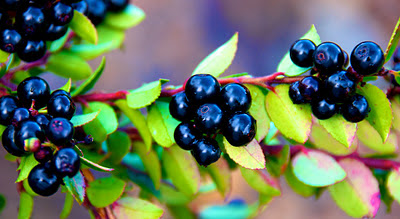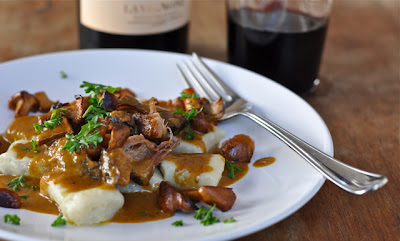So I went to my local meat shop and got a little more than three pounds of pork shoulder, which the butcher kindly cut into large chunks. This was a start. I wasn’t sure where I was going but Indian spices seemed like a reasonable next step, and maybe some dried prunes to accentuate the sweetness of the mushrooms and perhaps a splash or two (or three) of port wine. Yes, these ingredients would work together. With a nod to typical French braising, I added carrots and onions, but the final cilantro garnish would make it clear that this was not a dish with two feet in the Western culinary canon—more like a straddling of East and West.
Here, then, is a simple recipe built around dried candy cap mushrooms that is not a dessert.
1 cup dried candy caps, rehydrated with a 1 1/2 cups warm water
3 lbs boneless pork shoulder, cut into large chunks
2 tbsp olive oil
1 yellow onion, sliced into half moons
2 – 3 carrots, sliced into rounds
1 dozen prunes
1 cup port
2 bay leaves
Rub
1 tbsp garam masala
1 tsp salt
1 tsp coriander
1 tsp curry powder
1 tsp cumin seeds
1/2 tsp white pepper
1/2 tsp turmeric
1. In a medium sized bowl, rehydrate 1 cup dried candy cap mushrooms in enough warm water to cover, about 1 1/2 cups, for 20 minutes. Remove mushrooms and wring out excess liquid back into bowl. Soak prunes in stock.
2. Meanwhile, pre-heat oven to 325 degrees. Mix together rub ingredients and apply to pork chunks. Heat olive oil in a dutch oven or casserole over medium-high flame and brown meat, in batches if necessary.
3. Remove meat and add onions and carrots. Lower heat to medium and cook several minutes, stirring, until vegetables begin to soften. Add prunes, mushrooms, bay leaves, stock, and wine. Bring to a boil and return meat to pot. Spoon some of the vegetables on top. Liquid should mostly cover the meat but not entirely. Cover and put in oven for 1 1/2 to 2 hours, stirring occasionally, until meat falls apart.
The maple syrupy mushrooms marry nicely with the Indian spices. Substitute red or white wine for the port if you prefer. The finished pork, falling apart among bright orange bobs of stewed carrot, begs for a bright green garnish of cilantro—and I might have added a dollop of Greek yogurt on top if I’d had any. Served over this couscous, the meal was perfect for a wet winter evening.
And it just got better the next day: pulled pork sandwiches!































